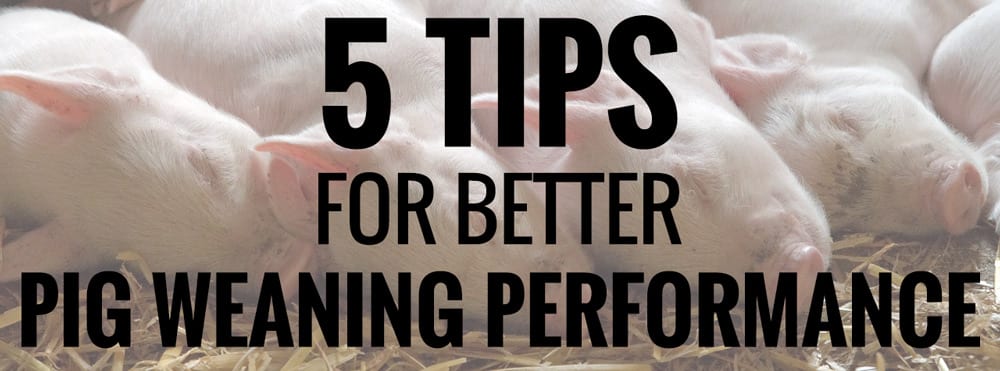Pig weaning is a time of significant change and stress in a pig’s life. In fact, that period has been noted by researchers as the most challenging in all of the hog production cycle. Piglets are weaned between three or four weeks of age. Though it may be economical, the transition to dry feed can present challenges. Pigs need to feed in order to grow and gain weight. Early feeders grow quicker and reach market weight earlier, which is obviously beneficial to the operation.
To get the best performance out of your herd, here is a short list of five pig weaning tips that can help to get positive results, and meet some of the challenges you may face in this transition period:
1. Keep Them Warm
 It’s important to maintain pig temperature requirements in order to promote healthy growth and reduce stress. Room temperature needs to be in the 70-75°F range. This can be a problem sometimes, especially in colder climates where it is costly to keep rooms well heated. Cold rooms can present the risk for health problems. Piglets spend considerable energy to keep their body temperature high enough. Consider introducing livestock heat pads to provide supplemental heat prior to and immediately after pig weaning, and they can provide an optimal environment for growing pigs.
It’s important to maintain pig temperature requirements in order to promote healthy growth and reduce stress. Room temperature needs to be in the 70-75°F range. This can be a problem sometimes, especially in colder climates where it is costly to keep rooms well heated. Cold rooms can present the risk for health problems. Piglets spend considerable energy to keep their body temperature high enough. Consider introducing livestock heat pads to provide supplemental heat prior to and immediately after pig weaning, and they can provide an optimal environment for growing pigs.
2. Clean Water
Water helps drive feed intake. It regulates body temperature, is essential to growth, aids in absorption of nutrients, and thus, weight gain. Sufficient amounts of water should be readily available throughout the pen. Nipple drinkers should be positioned so they are within reach for young pigs. Bowl drinker access should be at forty percent of shoulder height to ensure the water remains clean.
3. Biosecurity
It may be stating the obvious, but biosecurity measures should in place for the entire farm. Protecting the health of young pigs with specific swine disease prevention programs will make a difference. Keep a clean, warm pen, and be aware of signs of health-related problems. Prior to and around weaning, pigs do not yet have a fully developed immune system. During this time period, the protection from their maternal antibodies is decreasing. Ultimately, ensure your farm hands and staff are all on the same page with the disease prevention program with appropriate training. Healthy pigs will start eating sooner and gain weight quicker, which will help them perform better.
4. Proper Diet
As the piglets grow, their feeding habits change. An appropriate diet with optimized pig feed should be monitored and adjusted accordingly to match their age and weight. Enzyme supplements can enhance digestion, balance microflora, and contribute toward the good gut health of the animal. Creep feeding can prepare a pig’s digestive system for weaning as well as initiate and advance gut and digestive enzyme development.
See more in our complete pig feeding guide.
Knowing when and how much to feed is important, and training pigs to eat from certain feeders can be challenging. Piglets need to easily discover eating out of a trough when transitioning from the farrowing pen to the nursery or wean-to-finish building. Osborne’s FAST Start™ Big Wheel® Feeder can provide the necessary fresh feed on demand for growing pigs in wean-to-finish applications. The feeder is engineered to improve feed-to-gain ratios with virtually no waste. The big plus is the round trough—360° access to feed—which provides pigs with a less stressful eating environment, allowing them to easily find their new food source. The innovative feeding system allows newly weaned pigs as small as 10-14 lbs. to grow on a single feeder throughout their entire life cycle.
5. Sanitation
Keep the barn clean. Regular cleaning and disinfecting may not be fun, but it’s extremely important to keep your piglets healthy. Cleaning and disinfecting a building is a must. Rotate disinfectants periodically to ensure against organisms building up a resistance to any one disinfectant. Once the room has been thoroughly washed and cleaned, it should be dried before the next turn. Pigs are subject to respiratory infections, and a damp room can provide an environment detrimental to their health. Consult your local swine veterinarian for more information on maintaining a sanitation protocol.





